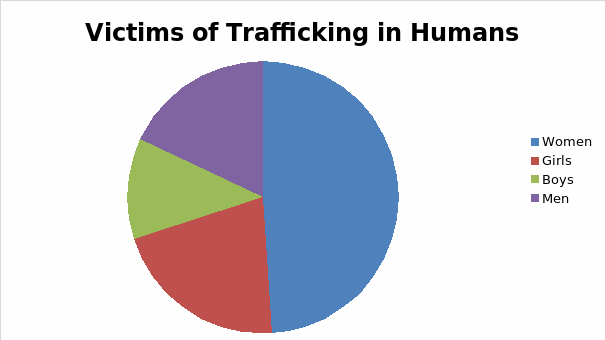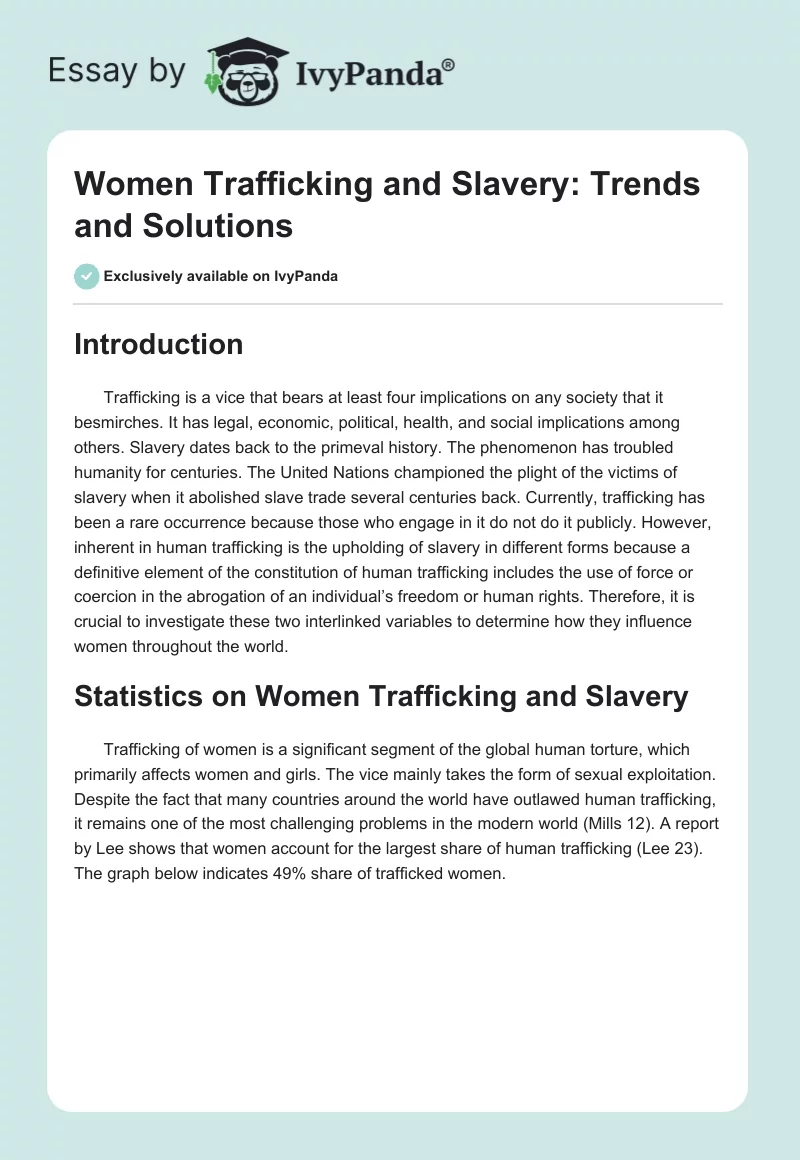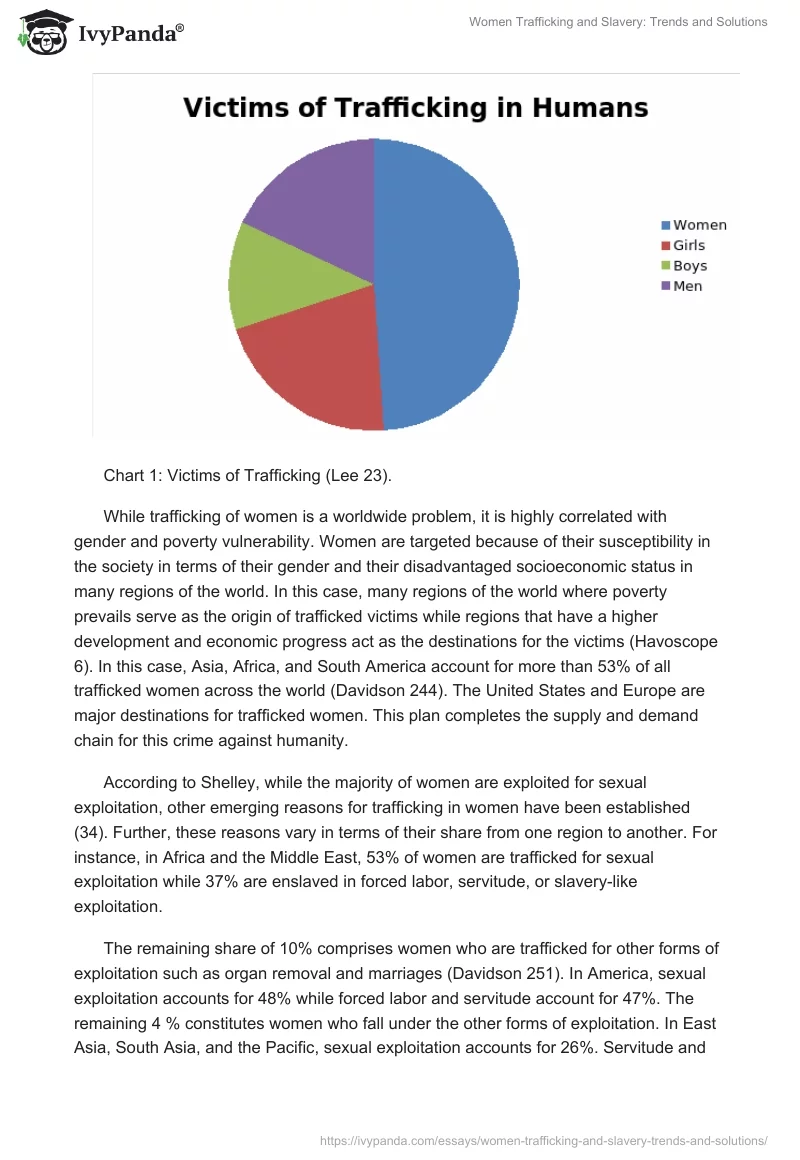Introduction
Trafficking is a vice that bears at least four implications on any society that it besmirches. It has legal, economic, political, health, and social implications among others. Slavery dates back to the primeval history. The phenomenon has troubled humanity for centuries. The United Nations championed the plight of the victims of slavery when it abolished slave trade several centuries back. Currently, trafficking has been a rare occurrence because those who engage in it do not do it publicly. However, inherent in human trafficking is the upholding of slavery in different forms because a definitive element of the constitution of human trafficking includes the use of force or coercion in the abrogation of an individual’s freedom or human rights. Therefore, it is crucial to investigate these two interlinked variables to determine how they influence women throughout the world.
Statistics on Women Trafficking and Slavery
Trafficking of women is a significant segment of the global human torture, which primarily affects women and girls. The vice mainly takes the form of sexual exploitation. Despite the fact that many countries around the world have outlawed human trafficking, it remains one of the most challenging problems in the modern world (Mills 12). A report by Lee shows that women account for the largest share of human trafficking (Lee 23). The graph below indicates 49% share of trafficked women.

While trafficking of women is a worldwide problem, it is highly correlated with gender and poverty vulnerability. Women are targeted because of their susceptibility in the society in terms of their gender and their disadvantaged socioeconomic status in many regions of the world. In this case, many regions of the world where poverty prevails serve as the origin of trafficked victims while regions that have a higher development and economic progress act as the destinations for the victims (Havoscope 6). In this case, Asia, Africa, and South America account for more than 53% of all trafficked women across the world (Davidson 244). The United States and Europe are major destinations for trafficked women. This plan completes the supply and demand chain for this crime against humanity.
According to Shelley, while the majority of women are exploited for sexual exploitation, other emerging reasons for trafficking in women have been established (34). Further, these reasons vary in terms of their share from one region to another. For instance, in Africa and the Middle East, 53% of women are trafficked for sexual exploitation while 37% are enslaved in forced labor, servitude, or slavery-like exploitation.
The remaining share of 10% comprises women who are trafficked for other forms of exploitation such as organ removal and marriages (Davidson 251). In America, sexual exploitation accounts for 48% while forced labor and servitude account for 47%. The remaining 4 % constitutes women who fall under the other forms of exploitation. In East Asia, South Asia, and the Pacific, sexual exploitation accounts for 26%. Servitude and forced labor account for 64% while other forms of exploitation account for 10% (Bales and Soodalter 36). The graph below gives a breakdown of the above statistics.

The Legal Perspective Concerning Women Slavery
Defining women trafficking and slavery based on the established statutory laws is critical to establish the status of women who migrate to other countries seeking better pastures only to end up in the hands of exploiters who abuse them sexually or even through forced and unpaid labor. Such a case falls under trafficking and slavery of women. Is there any possibility that such women may have waived their right to legal protection based on their consensual relocation? This dilemma is the outcome of the neo-abolitionist school of thought, which links the idea of trafficking with sexual abuse, especially on women (Chuang 1656).
Trafficking refers to the act of recruiting, moving, transporting, transferring, receiving, or accommodating persons through forceful, threatening, or coercive means, including abducting, defrauding, deceiving, or abusing of the fiduciary obligations that are owed to vulnerable beneficiaries with the motive of exploiting the victim in any of these situations purposefully to earn profit (Chuang 1657; Gergana-Danailova and Laczko 40). Due to the inherent characteristics of use of force, deception, fraud, and exploitation, trafficking of women amounts to modern-day women slavery.
Trafficking or slavery of women is a multi-pronged subject in legal discourses because it touches on human rights and freedoms, the migration laws, gender and minority policies among others. Moreover, although the Palermo Protocol guides the international arena on human trafficking and slavery, national laws differ broadly. Some countries have no effective policies that can govern these phenomena (Gergana-Danailova and Laczko 42).
New York offers a good example within the United States. As late as 2008, New York was yet to enact anti-trafficking laws that could guide the criminal prosecution of perpetrators of trafficking. As a result, conflict of laws is a common occurrence in law courts where such issues come up. A large percentage of cases may be struck out due to such gaps that lead to the denial of justice to the victims and perpetrators of women trafficking. In other cases, conflicts arise due to a difference in the basic legal structures and fundamentals such as the average age of most women trafficked and enslaved women. In such a scenario, a case of defilement of a 17-year-old minor may be thrown out some courts, especially if the courts define a minor as anybody who is below sixteen years. Every nation has a constitutional and international organ that addresses the issue of human rights and freedoms.
Trafficking of women contravenes these fundamental rights and freedoms. Each woman has a right to feel safe. It is against any person’s right to live in fear of death, punishment, or the loss of a loved one. Consequently, the trafficking of women is not only an affront to their rights but also a disgrace to the nation that espouses such said rights and values. Hence, the scope of the ramifications of trafficking and slavery cannot be overemphasized.
Trends on Women Trafficking
Each year, over 27 million people suffer exploitation or slavery in various contemporary situations while millions are made to cross borders as victims of trafficking. The US State Department estimates that over 820,000 people cross borders while being trafficked. This figure is corroborated by that of the International Organization for Migration, which stipulates it at roughly 800,000. Among these people, 1.39 million are specific victims of sexual exploitation while two-thirds of this figure comprises women and children, both within and without domestic borders. Research indicates that domestic trafficking of women usually takes the form of labor exploitation in sweatshops and house cleaning tasks. However, excessive violence is not witnessed in many cases of women slavery or exploitation because consent on the victims’ side (Belles 7).
The victims need an income to survive. Hence, they accede to their exploitation. However, it is also becoming apparent that transnational trafficking of women has its destination in commercial sex exploitation through channels such as prostitution where the women are given money to consent easily. However, in some cases, the clients end up threatening the women’s lives if they report the matter to other bodies. A research by Biden also makes it apparent that domestic trafficking occurs largely in the poorest countries (47).
For instance, in Indonesia, the International Labor Organization estimates over 700,000 women and child domestic workers. In this country, these women receive slave-like treatment and extreme conditions such as physical abuse, including whippings and sexual abuse in the various factories in which they are enlisted. Conflicts of the political nature and religious missions can also render large populations of people vulnerable to exploitation since they are internally displaced with little or no options for surviving (CME Resource/NetCE and Yick 5).
These factors have an intrinsic connection with development. During his acceptance of the Vital Voices Solidarity Award in New York, 2014, the United States Vice President, Joe Biden stated, “Violence against women is a stain on the moral character of a society in any country where it occurs” (Marcus par.3). Bidens gives interesting statistical observations on how he has encountered this monstrosity in various forms. He gives an example of the Democratic Republic of Congo where more than 1100 women are hospitalized each month because of rape that has been used as a weapon of war. This vice is tantamount to slavery because it is the equivalent to the domestic displacement of men and women to labor camps where they encounter harsh living conditions in the excuse of debt bondage.
In Nigeria, the Boko Haram is responsible for the abduction and exploitation and sometimes killing of more than 500 girls and women (Marcus par.31). Subsequently, this situation reveals the reason for creating protective women rights policies in the United States of America. The move was no walk in the park since it took over thirty years to get a working legislative framework in place to address the issue of women trafficking and slavery. Many nations that experience women trafficking or slavery lack such clear policies that address the matter. The United States experienced many cases before the inception of the campaign against the dehumanization of women in society (Belles 23). The move by America to implement working guidelines gives profound insights into the universality of this societal vice, especially with a focus on women. It makes it clear that culture, religion, or any other social obligation, tradition, or norm is not a valid excuse for the abuse of fundamental human rights. Biden tackles the matter of consent and the role that it plays in pushing women to slavery (Marcus par.15).
At the onset, the mentality that overrode any deliberations as to whether an atrocity had been committed to a woman or not was heavily hinged on her consent. Hence, in case a man rapes a woman brutally when she had consented to have a time out with a man, such a man cannot be found culpable of first-class sexual molestation (Falls and Falls 3). However, if the woman happens to be on her way when someone rapes her, this act amounted to first-class rape. However, current, America experiences very few cases of women slavery because the legislation and public opinions have revolutionized the situation such that even a husband is capable of raping his wife if he does not welcome the woman’s opinion on the matter. At first, it was difficult for the US to defend women since the common law background of the United States featured a patriarchal bias. It viewed women as chattels. Subsequently, the United States and many other nations that have noticed this flaw have since removed this bias in their legislative frameworks to adopt a more equalized approach to addressing women trafficking and slavery.
Solution to Women Trafficking and Slavery
In the past, the United Nations came up with sanctions and penalties for members who failed to eradicate women slavery in their countries. This strategy caused a great reduction in women exploitation. In fact, this intervention led to not only the abolition of the slave trade but also the gaining of independence by many nations that were colonized by superior powers. Another cause for concern is the assumption that informs anti-trafficking policies. Some policymakers claim that victims are always coerced into crossing borders before being forced by circumstances to engage in commercial sex for survival when no other employment options are available for their continued existence.
However, as pointed out earlier, in some cases, these assumptions are false. Some of these women may have been engaging in commercial sex before such that they opt to migrate in search of better opportunities only to end up in the hands of exploiters. In this particular case, consent is a debatable issue that can cause an occurrence of injustice (Marcus par.15). Consequently, the established legal framework is inadequately equipped to handle other surrounding factors such as the other women who suffer due to labor trafficking or migration exploitation.
Given this new stance that the international scene is assuming, it does not bode well for any nation that overlooks or downplays the seriousness of these crimes against women within its borders. Through the Palermo Protocol, the United Nations intends to eradicate this vice globally. To achieve this goal, sanctions will be placed on all non-compliant countries. A sanction greatly influences the economies of scale and other developmental issues in the culpable country. The adage, “United we stand, divided we fall” requires nations to pull together men, women, and children for optimal performance. The Chinese people have a maxim, “Women hold up the sky”, which reflects their high regard for the female gender and by extension, their great protection of women.
Conclusion
The trafficking of women largely undermines any society’s developmental potential. As such, women trafficking should be a primary concern for developing countries, which have the highest rate of this crime being perpetrated within and across their borders. Based on the expositions in the paper, lack of integrity and the underlying desperation to acquire wealth stand out as issues that lead to women participation in organized crimes with the view of earning profits. This paper has presented the issue of women trafficking or slavery as a serious offense where the perpetrators can be jailed for life for causing harm to innocent women. The formulation of proper policies will help to address the vice by imposing harsh penalties to those who will be found guilty.
Works Cited
Bales, Kevin, and Ron Soodalter. The Slave Next Door: Human Trafficking and Slavery In American Today, Oakland: California: University of California Press, 2010. Print.
Belles, Nita. In Our Backyard: Human Trafficking in America and What We Can Do to Stop It, The United Kingdom: Baker Books, 2015. Print.
Chuang, Janie. “Rescuing Trafficking from Ideological Capture: Prostitution Reform and Anti-trafficking Laws and Policies.” Journal of the University of Pennsylvania Law Review 158.6(2009): 1655-1728. Print.
CME Resource/NetCE, and Flanagan Yick. Human Trafficking and Exploitation, London: CME Resource/NetCE, 2014. Print.
Davidson, O’Connell. “New slavery, Old Binaries: Human Trafficking and the Borders of ‘Freedom.” Global networks 10.2 (2010): 244-261. Print.
Falls, Abraham, and Sheri Falls. Human Trafficking: Complete Series-Global Perspective of Sex Slavery, Young Man’s Point of View of Human Trafficking in Thailand, Mother’s Point of View…Trafficking, Sex Slavery, Thailand, Asia, New York, NY: Columbia University Press, 2014. Print.
Gergana-Danailova, and Frank Laczko. “Trafficking in Persons and Development: Towards Greater Policy Coherence.” Journal of International Migration 48.4(2010): 38-85. Print.
Havoscope. Human Trafficking: Prices and Statistics of the Modern-Day Slave Trade, London: Havoscope Books, 2015. Print.
Lee, Maggy. Human Trafficking, London: UK: Routledge, 2013. Print.
Marcus, Bennett. Read Joe Biden’s Powerful Speech about Combating Violence Against Women. 2014. Web.
Mills, Bright. Human Trafficking: Modern-Day Slavery, Bloomington: Trafford Publishing, 2011. Print.
Shelley, Louise. Human trafficking: A global perspective, The United Kingdom: Cambridge University Press, 2010. Print.


